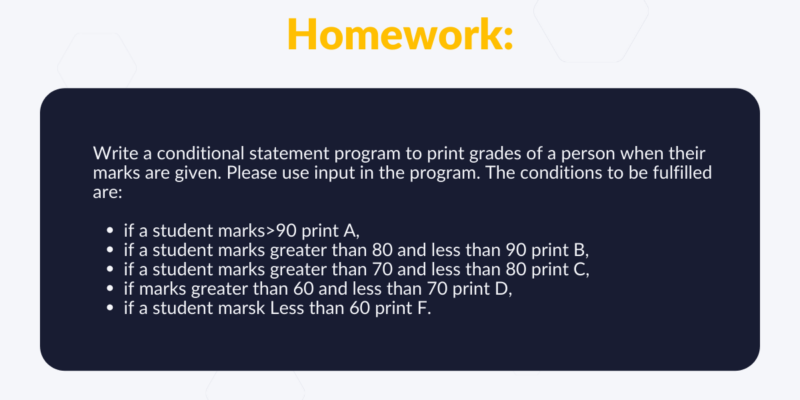Python 中的条件语句。 第 5 部分 Python 课程从初学者到高级,共 11 篇博文
已发表: 2021-12-30在之前的博文中,我们已经介绍了 Python 中的基本数据类型和高级数据类型。在本博客中,将介绍条件语句。 如果您是 Python 新手,请从第一篇博文开始,以更好地了解本博客。
Python 中的条件语句——目录:
- Python 中的条件语句——它们是做什么的?
- Python 输入()
- Python中的if语句
- Python 中的语法
- 如果在 Python 中其他
Python 中的条件语句——它们是做什么的?
Python 中的条件语句调节代码执行的流程。 用一个非常通俗的术语来说,当您希望程序在满足条件时执行任务并且在不满足条件时不执行相同任务时使用这些语句。
Python 输入()
到目前为止,我们只是打印了输出,但从未向我们的程序提供任何输入。 在 Python 中,input() 用于为 Python 中的程序提供输入。 示例如下图所示。
例如:
# Take input x=input() print(x)
上面的代码将要求一个输入,该输入将存储在 X 变量中以供进一步使用。
Output: 5 5
输入也可以有一个字符串查询。 示例如下图所示。
# Take input x=input(“please enter your age?”) print(x)
Output: please enter your age. 5 5
甚至可以使用数据类型的类型转换中使用的数据类型函数来修改输入。 示例如下图所示。
# Take input x=int(input(“please enter your age?”)) y=input(“please enter your age?”) print(type(x)) print(type(y))
Output: please enter your age. 5 please enter your age. 5 <class ‘int’> <class ‘str’>
在上面的例子中,我们可以看到没有任何类型转换函数的输入是一个字符串值。 因此,输入的默认值是字符串。
Python中的if语句
如果一个程序只有一个决定要做,那么使用一个“if”语句。 让我们举一个例子,我们希望仅当一个人有面具时才允许他或她。
#if statement mask=True if mask==True: print(“the person can enter”)
Python 中的语法
语法很简单,只要 if 语句中有内容,后面跟着条件和一个制表符空格的缩进。 当我们在变量博客中讨论运算符时。 我们讨论了比较运算符、逻辑运算符和数学运算符。
在这种情况下,可以使用比较运算符和逻辑运算符。 在上面的示例中,我们可以看到我们使用“==”运算符进行比较。 在上述程序中,如果掩码为 True,则将打印该语句,否则将不打印任何内容。
让我们执行程序并检查输出。
Output: the person can enter
如果我们将 make 值更改为 False 会发生什么? 输出将如下所示。 哪个是空的——因为条件不满足,所以不会打印任何内容。
Output:
如果在 Python 中其他
在上面的例子中,我们只有一个条件,如果一个人有面具,他们可以进入。 但是没有别的办法,如果这个人没有口罩怎么办。 因此,它似乎是一个不完整的程序。 假设他们没有口罩,我们希望他们戴上口罩才能进入。 为此,我们将使用 else 语句,该语句仅在“if”语句条件不满足时执行。
示例如下所示。
#if else statement mask=True if mask==True: print(“the person can enter”) else: print(“please, get a mask to enter”)
现在,如果我们将掩码的值更改为 False,那么我们将得到“请输入掩码”)
#if else statement mask=False if mask==True: print(“the person can enter”) else: print(“please, get a mask to enter”)
Output: please, get a mask to enter
这也可以写成下面的格式。
#if else statement mask=False if mask==True: print(“the person can enter”) print(“please, get a mask to enter”)
在 Python 中,每当你在 if 后面写一个不带缩进的语句时,它就在 else 语句之下。
现在我们添加一个案例,如果一个人没有口罩但愿意购买,可以从门卫自己那里购买口罩并进入。 为此,我们将稍微更改我们之前的代码。 我们将给出字符串值,例如“nobuy”、“buy”、“yes”。 现在我们将使用这些来编写我们的 if 语句。
#if else statement mask= if mask==”yes”: print(“the person can enter”) elif mask==”buy”: print(“person bought the mask and can enter”) print(“please, get a mask to enter”)
现在根据掩码值,执行将完成。 如果掩码值为“nobuy”,我们将得到输出为“please, get a mask to enter”。

#if else statement mask=”nobuy” if mask==”yes”: print(“the person can enter”) elif mask==”buy”: print(“person bought the mask and can enter”) print(“please, get a mask to enter”)
Output: please, get a mask to enter
即使掩码被赋予任何其他值,我们也会得到“请,获取掩码进入”的结果。 这是因为以上两个 if 语句条件都不会满足。
#if else statement mask=”yes” if mask==”yes”: print(“the person can enter”) elif mask==”buy”: print(“person bought the mask and can enter”) print(“please, get a mask to enter”)
对于掩码中的“是”值,输出将是“人可以进入”。
#if else statement mask=”yes” if mask==”yes”: print(“the person can enter”) elif mask==”buy”: print(“person bought the mask and can enter”) print(“please, get a mask to enter”)
Output: the person can enter
对于面具中的“购买”,输出将是(“人购买了面具并且可以进入”)。
#if else statement mask=”yes” if mask==”yes”: print(“the person can enter”) elif mask==”buy”: print(“person bought the mask and can enter”) print(“please, get a mask to enter”)
Output: the person bought the mask and can enter
在这篇博文中,我们介绍了 Python 中条件语句的一些基础知识,有关函数的更多主题将在下一篇博文中介绍。 从本博客开始,读者将获得一些练习题,本博客中的问题将在下一篇博客中提供答案。

您可能还喜欢我们从初级到高级的 JavaScript 课程。
作者:罗伯特·惠特尼
JavaScript 专家和指导 IT 部门的讲师。 他的主要目标是通过教其他人如何在编码时有效合作来提高团队生产力。
11 篇博文中从初级到高级的 Python 课程:
- Python课程简介。 第 1 部分 Python 课程从初学者到高级,共 11 篇博文
- Python 中的变量和数据类型。 第 2 部分 Python 课程从初学者到高级,共 11 篇博文
- Python 元组、列表、集合和字典。 第 3 部分 Python 课程从初学者到高级,共 11 篇博文
- Python 集和字典。 第 4 部分 Python 课程从初学者到高级,共 11 篇博文
- Python 中的条件语句。 第 5 部分 Python 课程从初学者到高级,共 11 篇博文
- Python中的循环。 第 6 部分 Python 课程从初学者到高级,共 11 篇博文
- Python 函数。 第 7 部分 Python 课程从初学者到高级,共 11 篇博文
- Python 中的高级函数。 第 8 部分 Python 课程从初学者到高级,共 11 篇博文
- Python 类和对象。 第 9 部分 Python 课程从初学者到高级,共 11 篇博文
- Python 中的文件。 第 10 部分 Python 课程从初学者到高级,共 11 篇博文
- 实践中的 Python 应用程序。 第 11 部分 Python 课程从初学者到高级,共 11 篇博文
